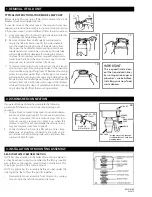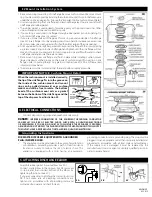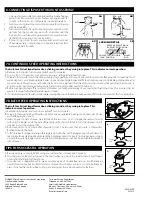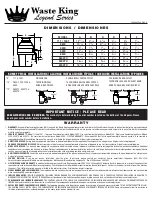
1. Line up disposer under mounting assembly. Guide hopper
projections into mount ring slots. Turn mount ring about 1/4”
to right so that disposer is temporarily supported (see 6A).
2. Turn mount ring and disposer until disposer elbow lines up
with trap (see 6B).
3. Turn mount ring to the right (counter-clockwise)until it locks
up tight. Tap the mount ring ears with a hammer until the
lock position is achieved. Hopper projections must be to ex-
treme left of mounting slots (see 6C & 6D).
4. If mount ring is hard to turn, you may add a small amount
of petroleum jelly or liquid soap to hopper projections. Run
water and check for leaks.
6. CONNECTING DISPOSER TO MOUNT ASSEMBLY
6C
6B
ELBOW
TRAP
LOCKING DETAIL
HOPPER PROJECTION IN
“SUPPORTED” POSITION
HOPPER PROJECTION IN
“LOCK” POSITION
MOUNT
RING
SLOT
PROJECTION
6A
6D
KINDRED Waste Disposers by Joneca Corporation
Franke Kindred Canada
1000 Franke Kindred Road,
Midland, Ontario, Canada
L4R 4K9
Customer Service Department
Telephone: 1-866-687-7465
Email: [email protected]
Monday - Thursday - 8:00 am to 5:00 pm
Friday - 8:00 am to 3:30 pm
Eastern Standard Time
KWD-01EZ
022013
7A. CONTINUOUS FEED OPERATING INSTRUCTIONS
the anti-Jam Swivel Impellers make a clicking sound as they swing into place. this indicates normal operation.
A. Remove sink stopper. Turn on a medium flow of cold water.
B. Turn switch to ON position; your motor is turning at full speed and ready to use.
C. Scrape in food waste. Down the drain go table scraps, peelings, rinds, seeds, pits, small bones and coffee grounds. To speed up food
waste disposal, cut or break up large bones, rinds and cobs. Large bones and fibrous husks require considerable grinding time and
are more easily thrown away with other trash. Do not be alarmed that the disposer slows down while grinding. The disposer is
actually increasing torque (grinding power) and is operating under normal conditions.
D. Before turning disposer off, let water and disposer run for approximately 15 seconds after shredding stops. This ensures that all
waste is thoroughly flushed through trap and drain.
E. It is not recommended to use hot water while running disposer. Cold water will keep waste and fats solid so disposer can flush away particles.
7B. BATCH FEED OPERATING INSTRUCTIONS
the anti-Jam Swivel Impellers make a clicking sound as they swing into place. this
indicates normal operation.
A. Remove sink stopper and turn on a medium flow of cold water.
B. Scrape in food waste. Down the drain go table scraps, vegetable peelings, cobs, rinds, pits, bones
and coffee grounds. (see A)
C. Insert stopper to start disposer. (see B) One of the two small slots in stopper base must line up
with switch plunger inside the neck of the disposer. Push down firmly to turn the disposer on. Lift
stopper to shut the disposer off.
D. Run disposer for 15 seconds after shredding stops. This ensures that all waste is thoroughly
flushed through the drain.
E. To fill sink, insert stopper and align the largest slot with the switch plunger. (see C) Push down to
seal sink without starting the disposer. When medium sized slot (see B) in stopper base is lined
up with the switch plunger, water can drain, but tableware, etc., cannot be accidentally dropped
into disposer.
TIPS FOR SUCCESSFUL OPERATION
A. Be sure disposer is empty before using your dishwasher so it may drain properly.
B. You may want to leave the stopper in the drain when not in use to prevent utensils and foreign
objects from falling into the disposer.
C. Your disposer is ruggedly built to give you many years of trouble free service. It will handle all
normal food wastes, but it will NOT grind or dispose of such items as plastic, tin cans, bottle caps,
glass, china, leather, cloth, rubber, string, clam and oyster shells, aluminum foil or feathers.
MEDIUM
SLOT
SMALL
SLOT
A
B
C
LARGE
SLOT






